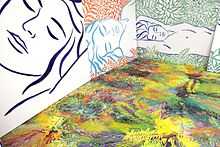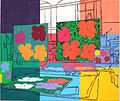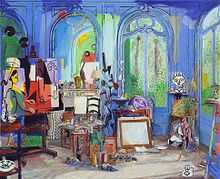Damian Elwes
Damian Elwes is a British artist who lives in the United States. His paintings explore themes such as the cycle of life, creativity and the connections between all living things. In his most recent work, he combines Duchamp's use of the keyhole and the Surrealist practice of making "double" paintings (images that have two subjects). Juxtaposing familiar and popular elements that don't usually go together, these paintings examine contemporary issues related to survival and extinction.
He is known for his series of paintings depicting the studios of the 20th century masters and for panoramas of the natural world which venture beyond the usual boundaries of landscape painting. His artwork is often monumental and three dimensional, such as a vast painting in which visitors walk from room to room on the ground floor of the "Villa La Californie "(2006), to witness the extent of Picasso's creativity in April 1956 or an immense landscape painting on the ground, "Amazon" (1999), on which visitors can walk above the flowering plants of a cloud forest and search for the source of the river.
Early life
Elwes was born in London in 1960, the second son of Tessa Kennedy and Dominick Elwes. He was educated at Harrow School and Harvard University. His grandfather was the royal portrait painter Simon Elwes R.A. and his father was also a painter but they both died when Damian was fifteen and left him their easels and paintbrushes. At sixteen Elwes bicycled from through France to Italy. At eighteen he backpacked from Argentina to Colombia, spending several weeks exploring the Amazon on a banana barge. Damian studied Literature at Harvard but at graduation, his play writing professor gave him a palette knife that had once belonged to Henri Matisse.[1] Instead of going to art school he went to Paris where, for two years, he made paintings of the studios of contemporary artists as a way of learning from them.
Work

In the 1980s, Elwes lived in New York, where he was an early exponent of graffiti art and came to know the artist Andy Warhol. In 1984 some of his early paintings were chosen by the eminent London art dealer Robert Fraser to be included in a graffiti exhibition with Jean-Michel Basquiat and Keith Haring.[2]
From 1992 to 2000, Elwes chose to live in southern Colombia so that he could make paintings about rain forests. There he created four "dream-sites", paintings so large that viewers can walk around inside them. A floor painting, "Fallen Tree" (1997) describes the cycle of life in one of the last surviving forests of mahogany. In a clearing in the forest, one old tree has fallen to the ground and is decaying. New saplings can be seen growing from the tree. This same cycle exists in painting, and in all innovation. So, while this work might be seen as a spur for conscience, it also contains an indication of Elwes' confidence in the power of creativity.[3] In London, 2010, Damian Elwes exhibited a huge floor painting about the origin of life. That art work describes a primary source of the Amazon River at the summit of a Colombian volcano called Puracé. It was placed under plexiglass in the gallery and visitors could walk all over it, to discover the hundreds of flowering plants beneath their feet. For the surrounding walls, Elwes created images (reminiscent of cave paintings) of a woman asleep in that exotic ecosystem.[4] Elwes also painted two multipart 360 degree paintings while in Colombia. The second of these, "Forest of Statues," is a circular painting based on the dimensions of "The Sanctuary" at Avebury.

On returning from life near the rain forest in 2000, Elwes began another series of paintings using the artist's studio as a metaphor for human creativity. So far he has painted many of the major studios of the twentieth century including those of Paul Gauguin, Pablo Picasso, Henri Matisse, Frida Kahlo, René Magritte, Marcel Duchamp, Andy Warhol and Salvador Dalí.[5] The English art historian Anthony Haden-Guest wrote "Elwes demonstrates that great artists provide food for more than just the eye. He wants the viewer to feel he is witnessing creation which is why his paintwork never sets out to confront his subjects “mano a mano” but has a feel of openness, of a space in which something is surely about to happen. In some sense, Elwes wants the viewer to feel what it is like to inhabit each of these painters. You do not absolutely have to know that Dalí similarly levitated Velasquez's studio in a painting, but, along with the immediate visual impact, such decodings are part of the pleasures of the work."[5]

A documentary titled "Inside Picasso's Studio" (2006) follows Elwes as he recreates almost the entire ground floor of Picasso's "Villa La Californie" as it was in April, 1956. The painting wraps around several walls and viewers are able to walk from room to room while observing hundreds of Picasso's recently created artworks and works in progress. Curator, Fred Hoffman wrote, "While we, the viewer, are immediately intrigued and invited to partake of these historical moments, what actually sustains, even heightens our interest, is Damian Elwes’ ability to turn documentation and historical record into compelling pictorial visions requiring repeated viewing and constant deciphering. Elwes’ concern for historical accuracy, and his subsequent investigative process enable his fully realized paintings to have a freshness and immediacy which none of the source material contains nor conveys. It is not, therefore, the fact that he has painted Picasso’s studio that makes Elwes’ work of interest. Rather, it is his ability to use the historical source material about Picasso to achieve some immediacy for his own concerns as a painter. In the end, it is the expressive quality of these works that we feel drawn to."[6]
Series of Paintings
Amazon, 1999 (Installation) A floor painting describes the kind of ecosystem which existed millions of years before humans and which is likely to exist millions of years from now.
Fallen Tree, 1998 (Installation) A floor painting which demonstrates how the cycle of life in a primary forest of mahogany is similar to the life cycle of man.
Forest of Statues, 1998 (Installation) 12 panels form a circular 360-degree painting of a forest where early humans have left carved statues.
Bull Paintings, 1993–2002 Meditations about the significance of cave paintings are brought to life because at 9 years old Elwes was gored and almost killed by a Spanish fighting bull.
Edge of the Forest, 1997 (Installation) 12 panels join together to form a square 360-degree painting. Viewers find themselves in an ancient garden with a house on one side and a forest on the other.
Paintings of Byron, Keats and Shelley in Italy, 1992-3
Paintings of the studios of 19th Century Masters, 2002–2004
Paintings of the studios of 20th Century Masters, 2004–12
Picasso's Villa La Californie, 2006-2012 (Installation) 8 panels connect and wrap around three walls. This painting describes a moment of intense human creativity.
Sleeping Women, 2010–12 These were created to be shown with the Amazon painting to indicate that the painting is about the source of life. In the mythology of some Amazonian tribes, the source of the river is the first woman and all life comes from her.
Exhibitions
- Francis Naumann Fine Art, 22 October - 15 December 2004[7]
- M&B Fine Art, 2 March - 15 May 2006[8]
- Lefevre Fine Art, 6 June - 4 July 2008[9]
- MortonMetropolis, 2 June - 16 July 2010[10]
Gallery
-

Source of the Amazon-gallery installation
-

Source of the Amazon (detail) 1998–2010
-

Fallen Tree, 1997
-

Bull l, 1993
-

Edge of the Forest (360-degree installation) 1997
-

Edge of the Forest 10 (part of a 360-degree landscape painting) 1997
-

Gauguin's Studio (Tahiti, 1895) 2007
-

Matisse's Studio (Collioure,1905) 2007
-

Warhol's Studio (New York, 1964) 2006
References
- ↑ Francis Naumann, Damian Elwes The Studios of Matisse, Picasso, Warhol and Duchamp, Francis Naumann Fine Art, New York, 2004
- ↑ ‘Paris-New York’ ‘ Robert Fraser Gallery at The Fruitmarket Gallery (Edinburgh) August 11-September 23, 1984
- ↑ 'Forest of Statues', Richard Salmon Gallery, London, August 5 - September 15, 1998
- ↑ http://agentmorton.com/exhibitions.php
- ↑ 5.0 5.1 Anthony Haden Guest, Damian Elwes Creative Spaces: the Studios of Dalí, Kahlo, Picasso and Matisse (Lefevre Fine Art, 2008)
- ↑ Fred Hoffman, Damian Elwes and the Modernist Heritage (M&B Fine Art, 2006)
- ↑ francisnaumann.com, retrieved 15 september 2011
- ↑ artscenecal.com, retrieved 15 september 2011
- ↑ lefevrefineart.com, retrieved 15 september 2011
- ↑ saatchi-gallery.co.uk, retrieved 15 september 2011
External links
|